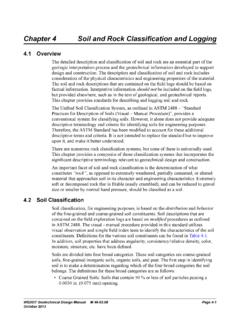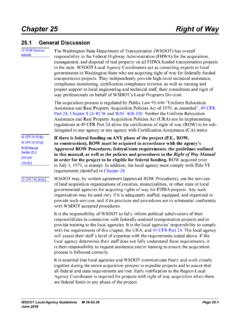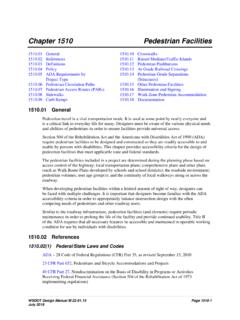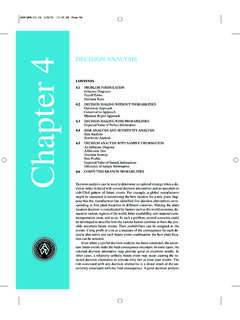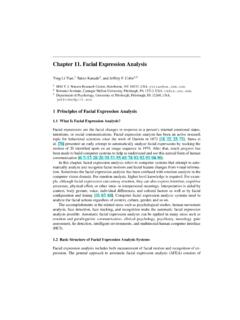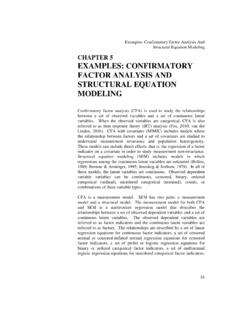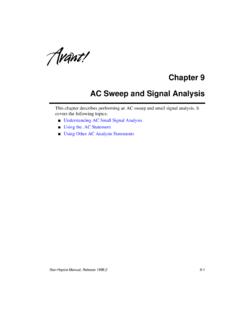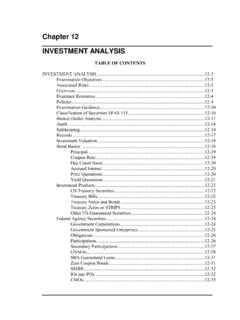Transcription of Chapter 7 Slope Stability Analysis
1 Chapter 7 Slope Stability Analysis7 .1 OverviewSlope Stability Analysis is used in a wide variety of geotechnical engineering problems, including, but not limited to, the following: Determination of stable cut and fill slopes Assessment of overall Stability of retaining walls, including global and compound Stability (includes permanent systems and temporary shoring systems) Assessment of overall Stability of shallow and deep foundations for structures located on slopes or over potentially unstable soils, including the determination of lateral forces applied to foundations and walls due to potentially unstable slopes Stability assessment of landslides (mechanisms of failure, and determination of design properties through back- Analysis ), and design of mitigation techniques to improve Stability Evaluation of instability due to liquefactionTypes of Slope Stability analyses include rotational Slope failure, translational failure, irregular surfaces of sliding, and infinite Slope failure.
2 Stability Analysis techniques specific to rock slopes, other than highly fractured rock masses that can in effect be treated as soil, are described in Chapter 12. Detailed Stability assessment of landslides is described in Chapter .2 Development of Design Parameters and Other Input Data for Slope Stability AnalysisThe input data needed for Slope Stability Analysis is described in Chapter 2 for site investigation considerations, Chapters 9 and 10 for fills and cuts, and Chapter 13 for landslides. Chapter 5 provides requirements for the assessment of design property input assessment of soil and rock stratigraphy is critical to the proper assessment of Slope Stability , and is in itself a direct input parameter for Slope Stability Analysis . It is important to define any thin weak layers present, the presence of slickensides, etc.
3 , as these fine details of the stratigraphy could control the Stability of the Slope in question. Knowledge of the geologic nature of the strata present at the site and knowledge of past performance of such strata may also be critical factors in the assessment of Slope Stability . See Chapter 5 for additional requirements and discussion regarding the determination and characterization of geologic strata and the determination of ESU s for design long-term or short-term Stability is in view, and which will control the Stability of the Slope , will affect the selection of soil and rock shear strength parameters used as input in the Analysis . For short-term Stability Analysis , undrained shear strength parameters should be obtained. For long-term Stability Analysis , drained shear strength parameters should be obtained.
4 For assessing the Stability of landslides, residual shear strength parameters will be needed, since the soil has in such has typically deformed WSDOT Geotechnical Design Manual M Page 7-1 October 2013enough to reach a residual value. For highly overconsolidated clays, such as the Seattle clays ( , Lawton Formation), if the Slope is relatively free to deform after the cut is made or is otherwise unloaded, even if a structure such as a wall is placed to retain the Slope after that deformation has already occurred, residual shear strength parameters should be obtained and used for the Stability Analysis . See Chapter 5 for requirements on the development of shear strength assessment of the groundwater regime within and beneath the Slope /landslide mass is also critical. Detailed pieziometric data at multiple locations and depths within and below the Slope will likely be needed, depending on the geologic complexity of the stratigraphy and groundwater conditions.
5 Potential seepage at the face of the Slope must be assessed and addressed. In some cases, detailed flow net Analysis may be needed. If seepage does exit at the Slope face, the potential for soil piping should also be assessed as a Slope Stability failure mechanism, especially in highly erodable silts and sands. If groundwater varies seasonally, long-term monitoring of the groundwater levels in the soil should be conducted. If groundwater levels tend to be responsive to significant rainfall events, the long-term groundwater monitoring should be continuous, and on-site rainfall data collection should also be .3 Design RequirementsLimit equilibrium methods shall be used to assess Slope Stability . The Modified Bishop, simplified Janbu, Spencer, or other widely accepted Slope Stability Analysis methods should be used for rotational, translational and irregular surface failure mechanisms.
6 Each limit equilibrium method varies with regard to assumptions used and how Stability is determined. Therefore, a minimum of two limit equilibrium methods should be used and compared to one another to ensure that the the level of safety in the Slope is accurately assessed. In cases where the Stability failure mechanisms anticipated are not well modeled by limit equilibrium techniques, or if deformation Analysis of the Slope is required, more sophisticated Analysis techniques ( , finite difference methods such as is used by the computer program FLAC) may be used in addition to the limit equilibrium methodologies. Since these more sophisticated methods are quite sensitive to the quality of the input data and the details of the model setup, including the selection of constitutive models used to represent the material properties and behavior, limit equilibrium methods should also be used in such cases, and input parameters should be measured or assessed from back- Analysis techniques whenever possible.
7 If the differences in the results are significant, the reasons for the differences shall be assessed with consideration to any available field observations to assess the correctness of the design model used. If the reasons for the differences cannot be assessed, and if the FLAC model provides a less conservative result than the limit equilibrium based methods, the limit equilibrium based methods shall govern the the potential Slope failure mechanism is anticipated to be relatively shallow and parallel to the Slope face, with or without seepage affects, an infinite Slope Analysis should be conducted. Typically, Slope heights of 15 to 20 feet or more are required to have this type of failure mechanism. For infinite slopes consisting of cohesionless soils that are either above the water table or that are fully submerged, the factor of safety for Slope Stability is determined as follows: Slope Stability Analysis Chapter 7 Page 7-2 WSDOT Geotechnical Design Manual M October 2013Ta n FS = (7-1) Tan Where: = the angle of internal friction for the soil = the Slope angle relative to the horizontalFor infinite slopes that have seepage at the Slope face, the factor of safety for Slope Stability is determined as follows.
8 B Ta n FS = (7-2) s Tan Where: b = the buoyant unit weight of the soil s = the saturated unit weight of the soilConsidering that the buoyant unit weight is roughly one-half of the saturated unit weight, seepage on the Slope face can reduce the factor of safety by a factor of two, a condition which should obviously be avoided through some type of drainage if at all possible; otherwise much flatter slopes will be needed. When using the infinite Slope method, if the FS is near or below to , severe erosion or shallow slumping Slope Stability Analysis Geotechnical Design Manual M 46-03 Chapter 7-4 December 2006 Slope Stability AnalysisDetailed assessment of the groundwater regime within and beneath the Slope is also critical.
9 Detailed pieziometric data at multiple locations and depths within and below the Slope will likely be needed, depending on the geologic complexity of the stratigraphy and groundwater conditions. Potential seepage at the face of the Slope must be assessed and addressed. In some cases, detailed flow net Analysis may be needed. If seepage does exit the Slope face, the potential for soil piping should also be assessed as a Slope Stability failure mechanism, especially in highly erodable silts and sands. If groundwater varies seasonally, long-term monitoring of the groundwater levels in the soil should be conducted. If groundwater levels tend to be responsive to significant rainfall events, the long-term groundwater monitoring should be .3 DesignRequirementsLimit equilibrium methodologies shall be used to assess Slope Stability .
10 The Modified Bishop, simplified Janbu, Spencer, or other widely accepted Slope Stability Analysis methods should be used for rotational and irregular surface failure mechanisms. In cases where the Stability failure mechanisms anticipated are not well modeled by limit equilibrium techniques, or if deformation Analysis of the Slope is required, more sophisticated Analysis techniques ( , finite difference methodologies such as is used by the computer program FLAC) may be used in addition to the limit equilibrium methodologies. Since these more sophisticated methodologies are quite sensitive to the quality of the input data and the details of the model setup, including the selection of constitutive models used to represent the material properties and behavior, limit equilibrium methods should also be used in such cases.



